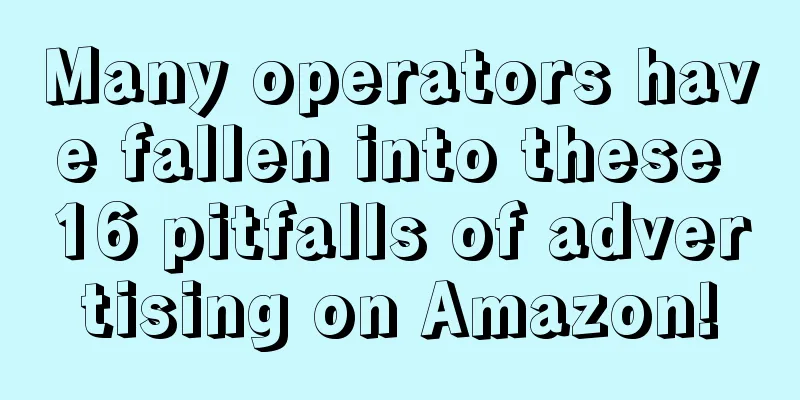|
As an important promotion method, Amazon advertising is very attractive to sellers. However, when using Amazon advertising, many sellers have some misunderstandings, which may affect the effectiveness of advertising. The editor lists some common misunderstandings about Amazon advertising, hoping that everyone can avoid these misunderstandings and improve the effectiveness of advertising. 1. Only run one type of ad This is a common mistake made by many novice sellers, who only run automatic ads or only run manual ads. The traffic expansion mechanisms of automatic advertising and manual advertising are completely different. Automatic advertising is completely run by algorithms, which can help us screen out more comprehensive product traffic, expand more keywords with good performance, and allow us to capture more keyword traffic. Its purpose is not only to place orders, but you should never simply think that automatic advertising will generate a lot of invalid traffic. If you only use manual advertising, then even if you understand the market and conduct in-depth research, it is impossible to manually filter out all product traffic. So don't just drive it in automatic or manual mode.2. Blind bidding and high budgetsWhen new products are listed, novice sellers directly set high bids and budgets according to the advertising suggestions, hoping to quickly accumulate weight and sales. However, new products without accumulation find it difficult to compete with leading products, resulting in high advertising costs and poor conversion rates. The correct approach is to gradually adjust advertising bids and budgets based on product rankings and sales trends. Some new sellers take it for granted when doing CPC, thinking that when products are not selling well, increasing the bid for keywords can make the display position more advanced and the ranking higher. They even think that high bids can bring a steady stream of orders. Little do they know that this idea is actually a big misunderstanding. Bids are not the only factor that affects ad ranking. The CTR (click-through rate) and CR (conversion rate) of your ad are equally important. Even if the bid is high, if the CTR and CR are low, ad ranking will be affected. Therefore, simply increasing the bid does not guarantee better ad ranking and sales. 3. Unreasonable budget allocation The same bid is set for all keywords, and the budget is not adjusted according to performance. 80% of the budget must be spent on ad groups with acos below 30%, and 20% on ad groups with acos above 30%, so as to ensure that there is no loss in advertising fees. Sellers need to adjust bids based on keyword performance and profit potential . Increase bids for keywords with good performance, and reduce bids or stop placing bids for keywords with poor performance. 4. Too many ad groups and scattered budgetsWithout understanding the advertising logic, novice sellers open multiple ad groups, thinking that this can cover more traffic entrances. However, too many ad groups will lead to budget dispersion and low conversion. The correct approach is to choose appropriate ad groups based on product subcategories, concentrate budget and resources, and promote conversions and rankings. 5. Adding too many keywords in manual adsToo many keywords will lead to competition between keywords, which will exhaust the advertising budget and cause insufficient exposure of long-tail keywords. Only relevant keywords can increase your visibility and sales. More keywords can bring more impressions, clicks, and traffic, but it doesn't always translate into more sales. Advertising campaigns should focus on conversions, not just impressions and traffic. Don’t use all keywords in your ads, but filter them by relevance. Overloading will only eat up your budget and give you a suboptimal ROI. Sellers should focus on selecting a few or dozens of key long-tail words as the main targets to ensure the accuracy and effectiveness of advertising. 6. Excessive pursuit of homepage header adsNew sellers mistakenly believe that high bids can make product ads appear at the top of the homepage, thereby gaining more sales. However, it is very difficult for a brand new listing to compete with top products. You should give your listing enough time to accumulate weight and sales, and gradually improve the ranking of your ads. Being ranked first allows ads to get the best exposure and the most traffic. But this does not always mean good conversions. In many cases, the cost will be more than the sales, so the ACOS will be very high. Most shoppers have a habit of clicking on the first page products, but that doesn’t mean they buy. If the goal of your Amazon advertising campaign is to increase brand awareness, being in the top position can be very helpful. However, as with most clients who use advertising, whose goal is to increase conversions, we should proceed with caution. By default, the BSR1 position is not the best position in all cases. Sellers need to try and find out what is best for us. 7. The initial research on keywords was not accurate, resulting in too much junk traffic Keywords are the entrance to Amazon’s internal traffic. Breaking through keyword operations can break through nearly 80% of Amazon’s internal traffic pool. However, many sellers do not spend enough time and are not careful enough when doing keyword research, which results in inaccurate keywords. When running ads, a large amount of junk traffic is generated, and operators need to spend a lot of time and energy to deny the junk words that come out of this or that ad, which not only wastes time, but also costs a lot of advertising fees.
8. Ignore the negative keyword feature The negative keyword function is an important means to effectively save advertising budget, but many sellers ignore this setting. Sellers need to set negative keywords reasonably to exclude search queries that are irrelevant to the products, improve the accuracy of advertisements, and avoid unnecessary waste of costs. 9. Not being able to properly structure your ads and putting all your listings in one ad group In fact, operating on Amazon is also a process of continuous trial and error. We often emphasize reducing the cost of trial and error, but we must never be unwilling to try even if we make mistakes. Therefore, it is an extremely wrong practice to create all listings in one ad group, which can sometimes be a fatal blow to advertising and product promotion. Sellers need to use different advertising groups to carry out actual delivery , and constantly conduct trial and error and make corrections based on the feedback from each set of advertising data in order to obtain the most optimized advertising delivery plan. 10. Advertising without optimizingSellers only see the role of advertising, but ignore that basic advertising is Listing optimization. Due to poor product display, even if the advertising brings exposure and clicks, when Listing is optimized, the advertising will be placed, but it cannot be converted into orders, wasting a lot of advertising costs. Before placing an advertisement, sellers must first optimize the product listing. Only when every detail of the product page is attractive, does it make sense to place an advertisement. 11. Frequently adjust poorly performing ads In the early stages of new product advertising, high ACoS is a normal phenomenon, because it takes a certain amount of time to accumulate advertising weight and key data. Frequent switching of ads will have a negative impact on ad weight, so ads need to be given enough running time so that they can be fully displayed and play their role.
12. Not regularly optimizing your ads Sellers need to continuously optimize and adjust during the process of advertising. For running ads, sellers need to check the advertising data, filter the advertising keywords according to the feedback from the data report, and add the keywords. At the same time, they should also appropriately adjust the daily budget of different advertising plans according to the changes in the ads. Only by continuously optimizing the ads can the advertising effect be closer to the expected level. 13. Setting ads regardless of time period ① The time period for advertising is not the best time period for placing orders. ② The impact of seasons, festivals, and peak and off-peak seasons on the performance of specific keywords is not taken into account. ③ The selected advertising report time period is too long or too short, or the selected time range is not very meaningful for reference. 14. Focusing on ACOs instead of organic order growth Advertising is a three-dimensional structure. Acos is indeed very important and directly reflects the advertising effect. But the ultimate goal of advertising is to get more organic orders. If organic orders account for 80% of advertising orders and advertising orders account for only 20%, then it doesn't matter if Acos is a little higher. We just need to ensure that we are profitable overall. 15. Neglecting competitor analysis Understanding competitors’ advertising strategies and performance can help sellers find entry points for optimizing advertising. Sellers should pay close attention to competitors’ advertising campaigns and compare and analyze them with them. 16. Ignoring product competitiveness Most importantly, sellers should understand that advertising is only a means to increase exposure and sales, and the quality and competitiveness of the product itself are the real factors that determine success. Sellers should pay attention to product quality, differentiation and user value before advertising.
|










